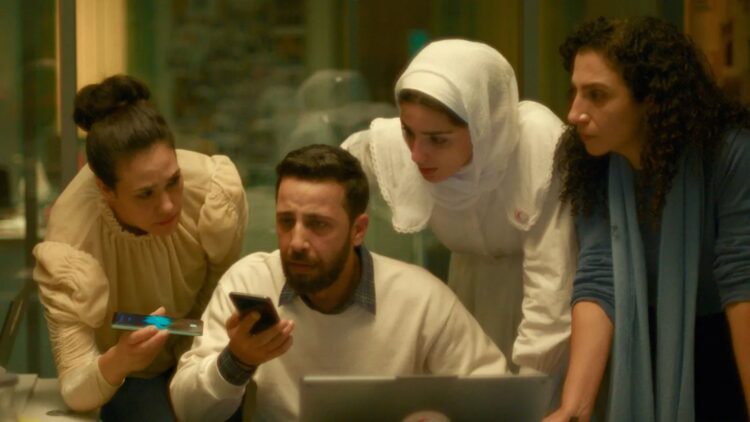
In January 2024, the Palestine Red Crescent Society received an emergency call from Hind Rajab, a five-year-old girl traveling in a car with her aunt, uncle, and cousins in Gaza City. The Israeli army fired upon their vehicle and killed everyone but Rajab, who managed to call for help while pinned between the corpses of her relatives. After spending hours on the phone, the Red Crescent was able to coordinate an ambulance to rescue her, which was then destroyed once it arrived. Rajab and the two ambulance workers sent to save her were found dead 12 days later, after Israeli forces withdrew from the area.
It’s one of many atrocities perpetrated by Israel in its ongoing genocide of the Palestinian people, which––since October 2023, at the time of this writing, and per estimates by the Gaza Health Ministry––has claimed over 60,000 Palestinian lives. When Kaouther Ben Hania heard audio of the calls between Rajab and Red Crescent volunteers, she paused work on her next feature to quickly assemble The Voice of Hind Rajab. Using testimonies from the Red Crescent workers who spoke with Rajab on the phone, she wrote a narrative from their perspective. Like her prior feature Four Daughters, she weaves in non-fiction elements, including Rajab’s actual voice from the calls, which we hear throughout. The result is a film noble in its intentions but filled with questionable choices around its execution, and Ben Hania’s direction fails to adequately address the concerns around this depiction.
Set entirely in the Red Crescent offices, the film begins with Omar (Mataz Malhees) speaking to Rajab before his colleague Rana (Saja Kilani) jumps in to assist while they wait on their supervisor Mahdi (Amer Hlehel) to get the green light for an ambulance (several miles away) to enter the area and save Rajab. As the minutes tick by, tensions rise in the office: as Omar and Rana break down over their inability to help, Mahdi has no choice but to navigate the hurdles of coordinating between Gazan and Israeli officials in order to obtain safe passage for the humanitarian workers to save her.
Maybe the biggest question, or the most immediate, would be about Ben Hania’s choice to construct this story as a nick-of-time thriller. Shooting with handheld cameras, she structures the film around plot developments meant to heighten the stakes, e.g. the belief that they’ve lost Rajab only to discover she’s still on the phone. It takes the shape of a genre film, except we have an awareness of the outcome that the characters don’t.
Ben Hania’s decision to go this route could be generously seen as an attempt to throw viewers into a similarly helpless role, or to use the immediacy to hook people into the story––even with their knowledge of its ending. But her direction is too flat and reliant on the genre modes she’s working within, which creates an unease. To hear Rajab’s real cries and pleas confined in a narrative and visual language associated with pulse-pounding entertainment suggests Ben Hania wants to translate her subject’s murder into something palatable for wider audiences.
The thought of applying palatability to the brutal slaughter of a child, her family, and her rescuers is a problematic one to say the least, which then gets to the question of why Ben Hania would choose to make The Voice of Hind Rajab this way. That big Hollywood names like Brad Pitt, Joaquin Phoenix, Rooney Mara, and Alfonso Cuarón have all signed on as executive producers doesn’t come as a surprise after watching it, given Ben Hania’s retelling in a mode more familiar to that side of the film industry. But this is also an industry where, less than 24 hours after my TIFF screening of The Voice of Hind Rajab, the festival awarded a documentary that lionizes a former general of the same army that murdered her. As heart-shattering as Hind Rajab’s story is, and as sincere as Ben Hania is in her efforts to bring awareness, it’s not enough to get past the discomfort of watching it in this manner.
There’s surely a case to be made that, if Ben Hania’s film gets enough people to become more aware of the genocide in Gaza, it constitutes a success. But after watching, for two years, Israel slaughtering innocent civilians, the idea of art enacting significant change seems narrow-minded. Such notions look more like the kind of mentality that’s brought us to this place. The Voice of Hind Rajab feels just as likely to inspire the kind of back-patting that’s become all too familiar within contemporary “political” cinema, where the passive act of watching a film like this, and acknowledging one’s own sympathy in responding to it, somehow equates to a form of direct action.
The Voice of Hind Rajab screened at TIFF 2025.
The post TIFF Review: The Voice of Hind Rajab Brings Questionable Palatability to the Genocide in Gaza first appeared on The Film Stage.











